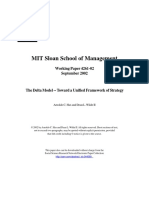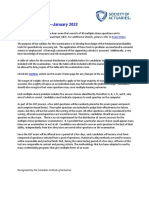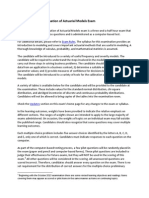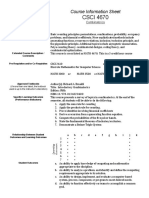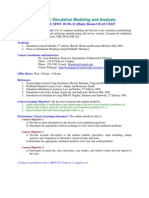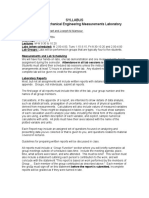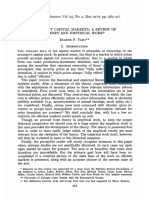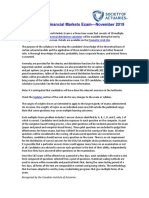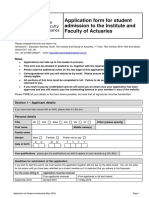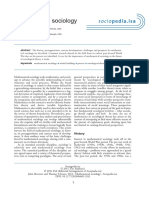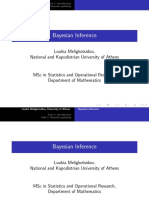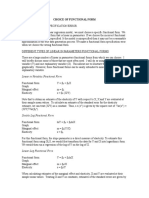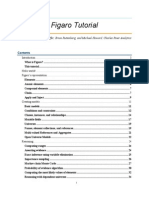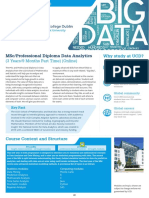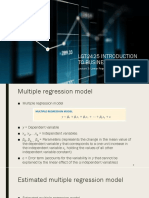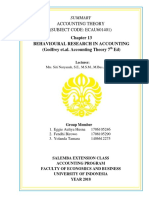2019 05 Exam SRM Syllabus
2019 05 Exam SRM Syllabus
Uploaded by
Sujith GopinathanCopyright:
Available Formats
2019 05 Exam SRM Syllabus
2019 05 Exam SRM Syllabus
Uploaded by
Sujith GopinathanOriginal Description:
Original Title
Copyright
Available Formats
Share this document
Did you find this document useful?
Is this content inappropriate?
Copyright:
Available Formats
2019 05 Exam SRM Syllabus
2019 05 Exam SRM Syllabus
Uploaded by
Sujith GopinathanCopyright:
Available Formats
Statistics for Risk Modeling Exam—May 2019
The Statistics for Risk Modeling exam is a three and one-half hour exam that consists of 35 multiple-choice
questions and is administered as a computer-based test (CBT). For additional details, please refer to Exam
Rules
The goal of the syllabus for this examination is to provide an understanding of the basics of several
important analytic methods. This exam is a prerequisite for the Predictive Analytics exam, which will go
deeper into each of the covered techniques.
The Statistics for Risk Modeling Exam assumes knowledge of probability and mathematical statistics as
covered in the Exam P and VEE Mathematical Statistics subjects.
The following learning objectives are presented with the understanding that candidates are allowed to use
specified calculators on the exam.
A variety of tables is available below for the candidate and will be provided to the candidate at the
examination. These include values for the standard normal distribution, t distribution and chi-square
distribution. Candidates will not be allowed to bring copies of the tables into the examination room.
Please check the Updates section on this exam's home page for any changes to the exam or syllabus.
Each multiple-choice problem includes five answer choices identified by the letters A, B, C, D, and E, only one
of which is correct. Candidates must indicate responses to each question on the computer. Candidates will
be given three and one-half hours to complete the exam.
As part of the computer-based testing process, a few pilot questions will be randomly placed in the exam
(both paper and pencil and computer-based forms). These pilot questions are included to judge their
effectiveness for future exams, but they will NOT be used in the scoring of this exam. All other questions will
be considered in the scoring. All unanswered questions are scored incorrect. Therefore, candidates should
answer every question on the exam. There is no set requirement for the distribution of correct answers for
the multiple-choice preliminary examinations. It is possible that a particular answer choice could appear
many times on an examination or not at all. Candidates are advised to answer each question to the best of
their ability, independently from how they have answered other questions on the exam.
Since the CBT exam will be offered over a period of a few days, each candidate will receive a test form
composed of questions selected from a pool of questions. Statistical scaling methods are used to ensure
within reasonable and practical limits that, during the same testing period of a few days, all forms of the test
are comparable in content and passing criteria. The methodology that has been adopted is used by many
credentialing programs that give multiple forms of an exam. Because this is a new exam, results for the first
several administrations will not be instantaneous. Results will be released on the SOA website about 8 weeks
after each testing window ends.
The ranges of weights shown in the Learning Objectives below are intended to apply to the large majority of
exams administered. On occasion, the weights of topics on an individual exam may fall outside the published
range. Candidates should also recognize that some questions may cover multiple learning objectives.
For this exam, ability to solve problems using the R programming language will not be assumed. However,
questions may present R output for interpretation.
Recognized by the Canadian Institute of Actuaries.
LEARNING OBJECTIVES
1. Topic: Basics of Statistical Learning (7.5-12.5%)
Learning Objectives
The Candidate will understand key concepts of statistical learning.
Learning Outcomes
The Candidate will be able to:
a) Explain the types of modeling problems and methods, including supervised versus
unsupervised learning and regression versus classification.
b) Explain the common methods of assessing model accuracy.
c) Employ basic methods of exploratory data analysis, including data checking and validation.
2. Topic: Linear Models (40-50%)
Learning Objectives
The Candidate will understand key concepts concerning generalized linear models.
Learning Outcomes
The Candidate will be able to:
a) Describe and explain the components of, in particular, the exponential family of distributions
and link functions.
b) Estimate parameters using least squares and maximum likelihood.
c) Interpret diagnostic tests of model fit and assumption checking, using both graphical and
quantitative methods.
d) Select an appropriate model, considering:
• Distributions and link functions
• Variable transformations and interactions
• Pearson chi-square statistic
• t and F tests
• AIC and BIC
• Likelihood ratio test
e) Interpret model results with emphasis on using the model to answer the underlying business
question.
f) Calculate and interpret predicted values, confidence, and prediction intervals.
g) Understand how approaches may differ compared to using an ordinary least squares model,
including lasso, ridge regression, and KNN.
3. Topic: Time Series Models (12.5-17.5%)
Learning Objectives
The Candidate will understand key concepts concerning regression-based time series models.
Learning Outcomes
The Candidate will be able to:
a) Define and explain the concepts and components of stochastic time series processes,
including random walks, stationarity, and autocorrelation.
b) Describe specific time series models, including, exponential smoothing, autoregressive, and
autoregressive conditionally heteroskedastic models.
c) Calculate and interpret predicted values and confidence intervals.
4. Topic: Principal Components Analysis (2.5-7.5%)
Learning Objectives
The Candidate will understand key concepts concerning principal components analysis.
Learning Outcomes
The Candidate will be able to:
a) Define principal components.
b) Interpret the results of a principal components analysis, considering loading factors and
proportion of variance explained.
c) Explain uses of principal components.
5. Topic: Decision Trees (10-15%)
Learning Objectives
The Candidate will understand key concepts concerning decision tree models.
Learning Outcomes
The Candidate will be able to:
a) Explain the purpose and uses of decision trees.
b) Explain and interpret decision trees, considering regression trees and recursive binary
splitting.
c) Explain and interpret bagging, boosting, and random forests.
d) Explain and interpret classification trees, their construction, Gini index, and entropy.
e) Compare decision trees to linear models.
f) Interpret the results of a decision tree analysis.
6. Topic: Cluster Analysis (10-15%)
Learning Objectives
The Candidate will understand key concepts concerning cluster analysis.
Learning Outcomes
The Candidate will be able to:
a) Explain the uses of clustering.
b) Explain K-means clustering.
c) Explain hierarchical clustering.
d) Explain methods for deciding the number of clusters.
e) Compare hierarchical with K-means clustering.
Textbooks
Regression Modeling with Actuarial and Financial Applications, Edward W. Frees, 2010, New York:
Cambridge. ISBN: 978-0521135962.
Chapter 1 – Background only
Chapter 2 – Sections 1-8
Chapter 3 – Sections 1-5
Chapter 5 – Sections 1-7
Chapter 6 – Sections 1-3
Chapter 7 – Sections 1-6
Chapter 8 – Sections 1-4
Chapter 9 – Sections 1-5
Chapter 11 – Sections 1-6
Chapter 12 – Sections 1-4
Chapter 13 – Sections 1-6
An Introduction to Statistical Learning, with Applications in R, James, Witten, Hastie, Tibshirani, 2013, New
York: Springer. A PDF version of the text can be downloaded at www.statlearning.com
Chapter 2 – Sections 1-3
Chapter 3 – Sections 1-6
Chapter 5 – Sections 1 and 3 (excluding 5.3.4)
Chapter 6 – Sections 1-7
Chapter 8 – Sections 1-3
Chapter 10 – Sections 1-6
While exercises are not included in the required readings, candidates are encouraged to work them as part
of the learning experience.
OTHER RESOURCES:
Tables for Exam SRM
Sample Questions and Solutions
You might also like
- Sage - Girden, 1992 ANOVA Repeated MeasuresDocument110 pagesSage - Girden, 1992 ANOVA Repeated MeasuresEntre0% (1)
- Regents Exams and Answers Geometry Revised EditionFrom EverandRegents Exams and Answers Geometry Revised EditionNo ratings yet
- Managerial Resources and RentsDocument17 pagesManagerial Resources and RentsSujith GopinathanNo ratings yet
- Delta Model Arnoldo HaxDocument36 pagesDelta Model Arnoldo HaxSujith GopinathanNo ratings yet
- Exam FM QuestioonsDocument102 pagesExam FM Questioonsnkfran100% (2)
- Exam FM QuestioonsDocument102 pagesExam FM Questioonsnkfran100% (2)
- Credit Scoring SASDocument42 pagesCredit Scoring SASjavierkztNo ratings yet
- 2024 05 Exam SRM SyllabusDocument6 pages2024 05 Exam SRM SyllabusAshish Kumar YadavNo ratings yet
- 2024 09 Exam SRM SyllabusDocument6 pages2024 09 Exam SRM SyllabusChau TaNo ratings yet
- 2022 01 Exam P SyllabusDocument5 pages2022 01 Exam P SyllabusLorenz Ceasar TubongbanuaNo ratings yet
- Edu 2018 09 P SyllabusDocument5 pagesEdu 2018 09 P Syllabuscamille_fayeNo ratings yet
- SOA Exam CDocument6 pagesSOA Exam CNoDriverNo ratings yet
- P Syllabus PDFDocument5 pagesP Syllabus PDFAakash AntilNo ratings yet
- Probability Exam-May 2019: UpdatesDocument5 pagesProbability Exam-May 2019: UpdatesAnonymous RNacXQNo ratings yet
- P SyllabusDocument5 pagesP SyllabusDudenNo ratings yet
- 2019 09 Exam P SyllabusDocument5 pages2019 09 Exam P SyllabusNickNo ratings yet
- 2020 01 Exam P Syllabi PDFDocument5 pages2020 01 Exam P Syllabi PDFSujith GopinathanNo ratings yet
- Probability Exam-January 2020: UpdatesDocument5 pagesProbability Exam-January 2020: UpdatesSujith GopinathanNo ratings yet
- Exam C Syllabus June 2016Document6 pagesExam C Syllabus June 2016phulam146No ratings yet
- Edu 2018 11 P SyllabusDocument5 pagesEdu 2018 11 P SyllabusUsherAlexanderNo ratings yet
- 2024 10 Exam Fam SyllabusDocument10 pages2024 10 Exam Fam SyllabusStanley ChivandireNo ratings yet
- Edu 2019 01 P Syllabus PDFDocument5 pagesEdu 2019 01 P Syllabus PDFFake NameNo ratings yet
- Predictive Analytics Exam-December 2018: Exam PA Home PageDocument8 pagesPredictive Analytics Exam-December 2018: Exam PA Home PagekidNo ratings yet
- Predictive Analytics Exam-December 2019: Exam PA Home PageDocument9 pagesPredictive Analytics Exam-December 2019: Exam PA Home PagejusttestitNo ratings yet
- Construction and Evaluation of Actuarial Models ExamDocument6 pagesConstruction and Evaluation of Actuarial Models ExamPisut OncharoenNo ratings yet
- 2019 02 Exam Stam Syllabi PDFDocument8 pages2019 02 Exam Stam Syllabi PDFAbdul HafeezNo ratings yet
- Short-Term Actuarial Mathematics Exam-June 2019Document8 pagesShort-Term Actuarial Mathematics Exam-June 2019Sujith GopinathanNo ratings yet
- Short-Term Actuarial Mathematics Exam-October 2018Document8 pagesShort-Term Actuarial Mathematics Exam-October 2018Bryan ChengNo ratings yet
- Short-Term Actuarial Mathematics Exam-October 2021Document8 pagesShort-Term Actuarial Mathematics Exam-October 2021Muchammad adrian FirmansyahNo ratings yet
- Short-Term Actuarial Mathematics Exam-June 2021Document8 pagesShort-Term Actuarial Mathematics Exam-June 2021masayoshi0ogawaNo ratings yet
- 2023 03 Exam Fam SyllabusDocument10 pages2023 03 Exam Fam SyllabusRussellGreenleeNo ratings yet
- Gis 2012 Paper Alina PettiferDocument8 pagesGis 2012 Paper Alina PettiferGABRIEL LUQUENo ratings yet
- 2024 MAY Exam P SyllabusDocument7 pages2024 MAY Exam P Syllabusairaf.liferemedynetworksNo ratings yet
- MASII Content OutlineDocument7 pagesMASII Content OutlineJiang Ruochen100% (1)
- 2012 July Exam PDocument3 pages2012 July Exam PLetsogile BaloiNo ratings yet
- P SyllabusDocument7 pagesP SyllabusAshish Kumar YadavNo ratings yet
- 2024 01 Exam P SyllabusDocument7 pages2024 01 Exam P SyllabusbenisNo ratings yet
- 2023 11 Exam P SyllabusDocument7 pages2023 11 Exam P SyllabusPhenyoRatsieNo ratings yet
- CSCI 4670: Course Information SheetDocument3 pagesCSCI 4670: Course Information SheetHendrian SagieNo ratings yet
- 文件2 Unlocking Academic Excellence Using Generative AI to Create Custom RubricsDocument5 pages文件2 Unlocking Academic Excellence Using Generative AI to Create Custom Rubricsnarjes.yeNo ratings yet
- ST3189 - Machine Learning - 2020 Examiners CommentariesDocument13 pagesST3189 - Machine Learning - 2020 Examiners CommentariesAmanda Beck BeltrameNo ratings yet
- M I B A: Q A QA: Ronald T. Chua (RTC) and Enrico C. Angtuaco (ECA)Document5 pagesM I B A: Q A QA: Ronald T. Chua (RTC) and Enrico C. Angtuaco (ECA)Yatheender P.MNo ratings yet
- Ime3300 S09Document6 pagesIme3300 S09Farhad EbrahimianNo ratings yet
- Syllabus EMAE 285 Mechanical Engineering Measurements LaboratoryDocument4 pagesSyllabus EMAE 285 Mechanical Engineering Measurements Laboratorybuzzboy3002No ratings yet
- cmp3 Nyc gr8 Scope and SequenceDocument8 pagescmp3 Nyc gr8 Scope and Sequenceapi-232678646No ratings yet
- BUSN603 Syllabus NewDocument7 pagesBUSN603 Syllabus NewPaul LeichtNo ratings yet
- ST104a Commentary 2022Document29 pagesST104a Commentary 2022Nghia Tuan NghiaNo ratings yet
- MKT2004: Research Methods For Business and Marketing: Revision Semester 2, 2010-11Document18 pagesMKT2004: Research Methods For Business and Marketing: Revision Semester 2, 2010-11ruixing111No ratings yet
- Principles of Management Accounting-Muhammad Junaid Ashraf & Abdul RaufDocument8 pagesPrinciples of Management Accounting-Muhammad Junaid Ashraf & Abdul RaufAnonymous qAegy6GNo ratings yet
- Statistics Course OutlineDocument5 pagesStatistics Course OutlineAnna kris DulfoNo ratings yet
- Probability Exam September 2016 Syllabus With Learning Objective/Outcomes and ReadingsDocument3 pagesProbability Exam September 2016 Syllabus With Learning Objective/Outcomes and ReadingsSaad MalikNo ratings yet
- QUESTION BANK ,sample paper , and many moreDocument43 pagesQUESTION BANK ,sample paper , and many morearyanagnihotri90No ratings yet
- Edu 2016 05 P Syllabus PDFDocument3 pagesEdu 2016 05 P Syllabus PDFJosh KhewNo ratings yet
- Assignment 3Document8 pagesAssignment 3Hoàng QuốcNo ratings yet
- Big Data & Business Analytics 2021 Q&aDocument4 pagesBig Data & Business Analytics 2021 Q&aSneha SabuNo ratings yet
- Usl 70 Marks Set 1Document2 pagesUsl 70 Marks Set 1Roshan KumarNo ratings yet
- Edu 2016 03 P Syllabus PDFDocument3 pagesEdu 2016 03 P Syllabus PDFEdmond KeraNo ratings yet
- MGMT E-104: Quantitative Methods For Economics and Finance: Course OverviewDocument7 pagesMGMT E-104: Quantitative Methods For Economics and Finance: Course OverviewmiguelNo ratings yet
- Assignment EditedDocument5 pagesAssignment Editedbharat sangroulaNo ratings yet
- ST3188 Commentary 2022Document16 pagesST3188 Commentary 2022dth090702No ratings yet
- Data Flow Diagram of College Management SystemDocument8 pagesData Flow Diagram of College Management SystemRs Vinayagam33% (3)
- ST104a 2022 October CommentariesDocument17 pagesST104a 2022 October CommentariesIgor MirandaNo ratings yet
- EC7091 Module Outine 2014-15Document11 pagesEC7091 Module Outine 2014-15winblacklist1507No ratings yet
- MBA133 Courseplan LDocument7 pagesMBA133 Courseplan LSoham SamantaNo ratings yet
- The Dynamics of Industrial Capitalism Perspectives On AlfredDocument29 pagesThe Dynamics of Industrial Capitalism Perspectives On AlfredSujith GopinathanNo ratings yet
- Achieving Managerial Synergism: Balancing Strategic Business Units and Profit CentersDocument15 pagesAchieving Managerial Synergism: Balancing Strategic Business Units and Profit CentersSujith GopinathanNo ratings yet
- Why Focussed Strategies May Be Wrong For Emerging MarketsDocument8 pagesWhy Focussed Strategies May Be Wrong For Emerging MarketsSujith GopinathanNo ratings yet
- Leadership and TurnaroundsDocument12 pagesLeadership and TurnaroundsSujith GopinathanNo ratings yet
- Corporate Finance Over The Past 25 YearsDocument29 pagesCorporate Finance Over The Past 25 YearsSujith GopinathanNo ratings yet
- Emh Fama 1970Document35 pagesEmh Fama 1970Sujith GopinathanNo ratings yet
- Short-Term Actuarial Mathematics Exam-June 2019Document8 pagesShort-Term Actuarial Mathematics Exam-June 2019Sujith GopinathanNo ratings yet
- Fall 2019 Ltam Syllabus PDFDocument7 pagesFall 2019 Ltam Syllabus PDFSujith GopinathanNo ratings yet
- 2020 01 Exam P Syllabi PDFDocument5 pages2020 01 Exam P Syllabi PDFSujith GopinathanNo ratings yet
- Probability Exam-January 2020: UpdatesDocument5 pagesProbability Exam-January 2020: UpdatesSujith GopinathanNo ratings yet
- Economic Analysis and Strategic ManagementDocument24 pagesEconomic Analysis and Strategic ManagementSujith GopinathanNo ratings yet
- Application Form For Student Admission To The Institute and Faculty of ActuariesDocument10 pagesApplication Form For Student Admission To The Institute and Faculty of ActuariesSujith GopinathanNo ratings yet
- Ifm Derivatives Questions SolutionsDocument105 pagesIfm Derivatives Questions SolutionsMaratNo ratings yet
- Investment & Financial Markets Exam-November 2019: Normal Distribution Calculator Prometric Web SiteDocument12 pagesInvestment & Financial Markets Exam-November 2019: Normal Distribution Calculator Prometric Web SiteSujith GopinathanNo ratings yet
- 2018 Exam Ifm Sample Questions PDFDocument89 pages2018 Exam Ifm Sample Questions PDFSujith GopinathanNo ratings yet
- Application Form For Student Admission To The Institute and Faculty of ActuariesDocument10 pagesApplication Form For Student Admission To The Institute and Faculty of ActuariesSujith GopinathanNo ratings yet
- Why 70 - 30 or 80 - 20 Relation Between Training and Testing Sets - ADocument7 pagesWhy 70 - 30 or 80 - 20 Relation Between Training and Testing Sets - ADianaNo ratings yet
- PDF Real Estate Modelling and Forecasting Chris Brooks downloadDocument81 pagesPDF Real Estate Modelling and Forecasting Chris Brooks downloadfulariayinla100% (1)
- Sampling Waste Piles: Standard Guide ForDocument12 pagesSampling Waste Piles: Standard Guide ForFanambinantsoa Eddy RAKOTONDRAZAFYNo ratings yet
- MathematicalSociology PDFDocument14 pagesMathematicalSociology PDFĐorđe MakiNo ratings yet
- Epfl Chapter 7Document18 pagesEpfl Chapter 7ioanciorneiNo ratings yet
- Sol HW6Document15 pagesSol HW6Ked LukkedNo ratings yet
- The Risk of Automation For Jobs in OECD Countries: OECD Social, Employment and Migration Working Papers No. 189Document35 pagesThe Risk of Automation For Jobs in OECD Countries: OECD Social, Employment and Migration Working Papers No. 189EjazSulemanNo ratings yet
- Montgomery Design and Analysis of Experiments Wiley 2012Document757 pagesMontgomery Design and Analysis of Experiments Wiley 2012Manan Vaja100% (4)
- Philosophy and The Practice of Bayesian Statistics in The Social SciencesDocument14 pagesPhilosophy and The Practice of Bayesian Statistics in The Social SciencesAnonymous 6duRJjXKNo ratings yet
- Bayes Slides1Document146 pagesBayes Slides1Panagiotis KarathymiosNo ratings yet
- Sap Demand Planning (DP) 26125070 PDFDocument40 pagesSap Demand Planning (DP) 26125070 PDFOshun Tang100% (2)
- Wafo Tutorial 2017Document195 pagesWafo Tutorial 2017Marc100% (1)
- Choice of Functional FormDocument4 pagesChoice of Functional Formsabir17No ratings yet
- Module 3 PDFDocument23 pagesModule 3 PDFSherwinEscanoNo ratings yet
- AUST Measurements LabDocument46 pagesAUST Measurements LabNazmul Haque ParthibNo ratings yet
- Figaro TutorialDocument69 pagesFigaro TutorialKeeNo ratings yet
- Independent Component Analysis: 7.1 Limitations of The Sparse Coding ApproachDocument25 pagesIndependent Component Analysis: 7.1 Limitations of The Sparse Coding ApproachbitsmohanNo ratings yet
- Msc/Professional Diploma Data Analytics: Why Study at Ucd?Document2 pagesMsc/Professional Diploma Data Analytics: Why Study at Ucd?urhenNo ratings yet
- LGT2425 Lecture 3 Part II (Notes)Document55 pagesLGT2425 Lecture 3 Part II (Notes)Jackie ChouNo ratings yet
- Strut and Tie Model Deep Beam DesignDocument10 pagesStrut and Tie Model Deep Beam DesignAzhar PLNo ratings yet
- Roberts, David W. - Comparison of Distance Based and Model Based OrdinationsDocument35 pagesRoberts, David W. - Comparison of Distance Based and Model Based OrdinationsHolaq Ola OlaNo ratings yet
- Group 5 Summary Accounting Theory 12th Meeting Behavioural Research in AccountingDocument9 pagesGroup 5 Summary Accounting Theory 12th Meeting Behavioural Research in AccountingEggie Auliya HusnaNo ratings yet
- Notes CPM & PertDocument8 pagesNotes CPM & Pertvamsi krishna balaga50% (2)
- How Operations Research Is Applied in Industry BusinessDocument19 pagesHow Operations Research Is Applied in Industry BusinessInternational Journal of Innovative Science and Research TechnologyNo ratings yet
- Development of Robust Design Under Contaminated and Non-Normal DataDocument21 pagesDevelopment of Robust Design Under Contaminated and Non-Normal DataVirojana TantibadaroNo ratings yet
- Bayesian Statistics and ModellingDocument28 pagesBayesian Statistics and Modellingmainking2003No ratings yet
- M2S2 - Statistical Modelling: DR Axel Gandy Imperial College London Spring 2011Document25 pagesM2S2 - Statistical Modelling: DR Axel Gandy Imperial College London Spring 2011Nat LeungNo ratings yet
- Am (101-120) Analisis MultinivelDocument20 pagesAm (101-120) Analisis Multinivelmaximal25No ratings yet



